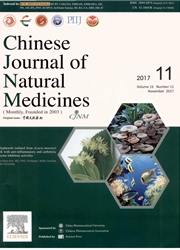

 中文摘要:
中文摘要:
Soy isoflavones exert a wide variety of biological activities, such as antioxidant, anti-inflammatory and anti-cancer properties. Nuclear factor erythroid 2-related factor 2(Nrf2), a b Zip transcription factor, plays a key role in soy isoflavones induced protection against oxidative stress and cancer. To obtain more effective isofavones, a series of 7,4′-bis-(3-amino-2-hydroxypropoxy), 7 or 4′-(3-amino-2-hydroxypropoxy) isoflavone derivatives have been synthesized as potential antitumor agents and Nrf2/ARE(antioxidant response element) activators. The cytotoxicity of these compounds in human cancer cell lines MDA-MB-231, HT-29, HCT116, Hep G2 and 7402 was tested by MTT assay. In this study, the cytotoxicity of compound 3b exhibited highest cytotoxic activity and at the safety dose range, it also strongly up-regulated antioxidant response element(ARE)-luciferase reporter activity. In addition, compound 3b induced Nrf2 nuclear translocation and upregulated its downstream target genes NQO-1 and HO-1 at protein level. Taken together, our results suggest that compound 3b could be a potential agent for cancer themotherapy or cancer chemoprevention.
 英文摘要:
英文摘要:
Soy isoflavones exert a wide variety of biological activities, such as antioxidant, anti-inflammatory and anti-cancer properties. Nuclear factor erythroid 2-related factor 2(Nrf2), a b Zip transcription factor, plays a key role in soy isoflavones induced protection against oxidative stress and cancer. To obtain more effective isofavones, a series of 7,4′-bis-(3-amino-2-hydroxypropoxy), 7 or 4′-(3-amino-2-hydroxypropoxy) isoflavone derivatives have been synthesized as potential antitumor agents and Nrf2/ARE(antioxidant response element) activators. The cytotoxicity of these compounds in human cancer cell lines MDA-MB-231, HT-29, HCT116, Hep G2 and 7402 was tested by MTT assay. In this study, the cytotoxicity of compound 3b exhibited highest cytotoxic activity and at the safety dose range, it also strongly up-regulated antioxidant response element(ARE)-luciferase reporter activity. In addition, compound 3b induced Nrf2 nuclear translocation and upregulated its downstream target genes NQO-1 and HO-1 at protein level. Taken together, our results suggest that compound 3b could be a potential agent for cancer themotherapy or cancer chemoprevention.
 同期刊论文项目
同期刊论文项目
 同项目期刊论文
同项目期刊论文
 期刊信息
期刊信息
